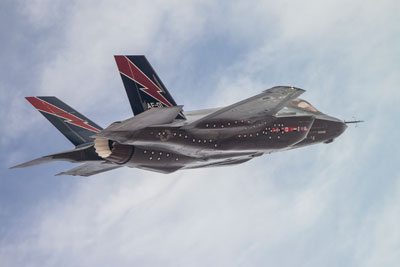
Features
Military
Glide Path: Deciphering the F-35 conundrum
Numbers, numbers, numbers. We’ve heard nothing else about the Lockheed Martin F-35 Lightning II project for months.
March 6, 2013 By Paul Dixon
Numbers, numbers, numbers. We’ve heard nothing else about the Lockheed Martin F-35 Lightning II project for months. Everyone’s got a different number and a different twist on the final purchase price depending on your point of view. The federal government originally started off with $9 billion as the “acquisition” cost. The dollars grew exponentially, as first the parliamentary budget officer and then the auditor general weighed in, pointing out details that had been omitted from the original rosy estimates, such as operating costs.
 |
|
| “You have to have your undercoating, after all . . . got to have it for those long, cold winters up north.” PHOTO: Lockheed Martin
|
KPMG had the final word on this chapter of the process when it unveiled its definitive amount of $45.8 billion, which includes the acquisition cost of the aircraft as well as the costs associated with operating them for a projected 42-year life span. That time line sounds crazy until you consider it is measured from the time the first aircraft is accepted until the last aircraft is retired, which will likely be a similar number for the CF-18.
It was at this point that defence minister Peter MacKay hit the “reset” button while conceding that in that $9 billion price tag operating costs were not taken into account. MacKay and Public Works Minister Rona Ambrose are quoting the cost on the terminology “life cycle” as in “the full 42-year life cycle” of the aircraft. They’d also have us believe that they really did know that the $9 billion was the sticker price on the dealer’s lot. But does that include tax? Dealer prep is also extra – and don’t forget about dealer prep. You have to have your undercoating, after all, got to have it for those long, cold winters up north and it’s on special this week (just for you, but don’t tell my boss). What we have seen here could be the lost episode of The King of Kars, that lighthearted reality show of a few years ago.
Over the past several months, the numbers have been batted about like a beach ball on a windy day – and the sad truth is that depending on how you choose to define the parameters of the deal and the time frame, then any particular number can be held up as being correct.
At the 2012 Abbotsford International Air Show, I had my 15-minute one-on-one with the F-35 project team in the Lockheed chalet: the Canadian pilot who rhapsodized about the aircraft under the watchful eyes of the people from head office (disclosure, they offered me lunch from a lavish buffet, but I declined though I did have a glass of water).
That was all well enough, but what impressed me most that day was the representative I met from a local waste haulage outfit. There was a shiny new garbage truck on display right beside the media tent (which strangely enough was located about as far as you could be from chalet row and still be on the airport grounds). What started out as trading jokes with the fellow became a very serious discussion about the waste removal business in general and the truck in particular.
The company is a large multinational that has recently taken over a large municipal contract in metro Vancouver. The truck, straight from the factory, was one of 50 that would service this particular contract. Talking numbers with the ops manager, it was clear that he knew his business. The diesel engine runs on just about anything that is combustible, so that as fuel costs vary and alternative fuels become more widely available the company will be able to source its fuel accordingly. A safety management system in a garbage truck? Absolutely! The truck features multiple video cameras that can be set up to record the external operations as well as the driver’s position. Data capture on all facets of vehicle operation allows you to monitor both the driver as well as maintenance requirements. The life cycle of the truck is projected at 10 years and the company has the costs pegged for that entire time, from labour to fuel to simply maintaining the vehicle.
The main difference between the garbage truck and the F-18 replacement is that, in the case of the garbage truck, there is a clear understanding of what that truck will be doing over the course of its lifetime. In choosing an airplane, it’s difficult to make the “right” decision when there is no clear vision of what we will expect of our military five, 10 or 20 years from now. It’s been said many times before, but it fits here – if you don’t know where you are going then any road will take you there. That’s where you find the “reset” key – halfway between where you are and the “any” key. Doh!
Paul Dixon is freelance writer and photojournalist living in Vancouver.